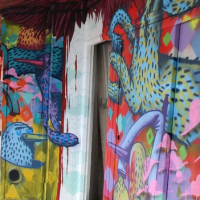Graffiti Goes Digital with Google’s Street Art Project

Are the images on the wall of that building and under that bridge graffiti or art? Should they be scrubbed off or celebrated and preserved? According to Google, a great number of the images out there are indeed art. And yes, they should be immortalized—at least digitally.
The Paris-based Google Cultural Institute, essentially a virtual museum that curates and preserves cultural content for online audiences, has unveiled its latest endeavor: Google's Street Art Project. It’s an ongoing collection of iconic art from streets across the globe, with more than 5,000 images from approximately one hundred exhibitions.
Street art has always been ephemeral. “Here today, gone tomorrow” is part of its appeal, but it's often frustrating. The mural that made you stop in awe may be gone the next time you pass by. Art has always been a compelling interpretation of history as well, which calls for preservation.
As Lucy Schwartz, the program manager at the Google Cultural Institute, says in Google’s blog, “Some of this work was created as a means of expression and activism, like the Chilean open-sky museums of La Pincoya and San Miguel, which were born as community projects to transform poverty-stricken neighborhoods, or to make a political statement like in London and Atlanta.”
However, some view street art as a form of vandalism. As The New York Times points out:
Google is taking pains to avoid offense by setting strict conditions. It will include only images provided by organizations that sign a contract attesting that they own the rights to them. It will not cull through Street View images but will provide the technology to organizations that want to use it to record street art legally. Some groups have provided exact locations of the artworks; others have not.
If you’re interested in the back story of street art, you can learn about the history and evolution of graffiti and style writing to street art. From the brief history on the website:
Street Art covers an extreme variety of techniques, allowing new approaches that go well beyond traditional graffiti and spray paint. At the turn of the twenty-first century new comers like JR take the street as the largest gallery in the world. An open sky museum for all.
What’s your favorite? The world is a canvas—the #streetartproject.

